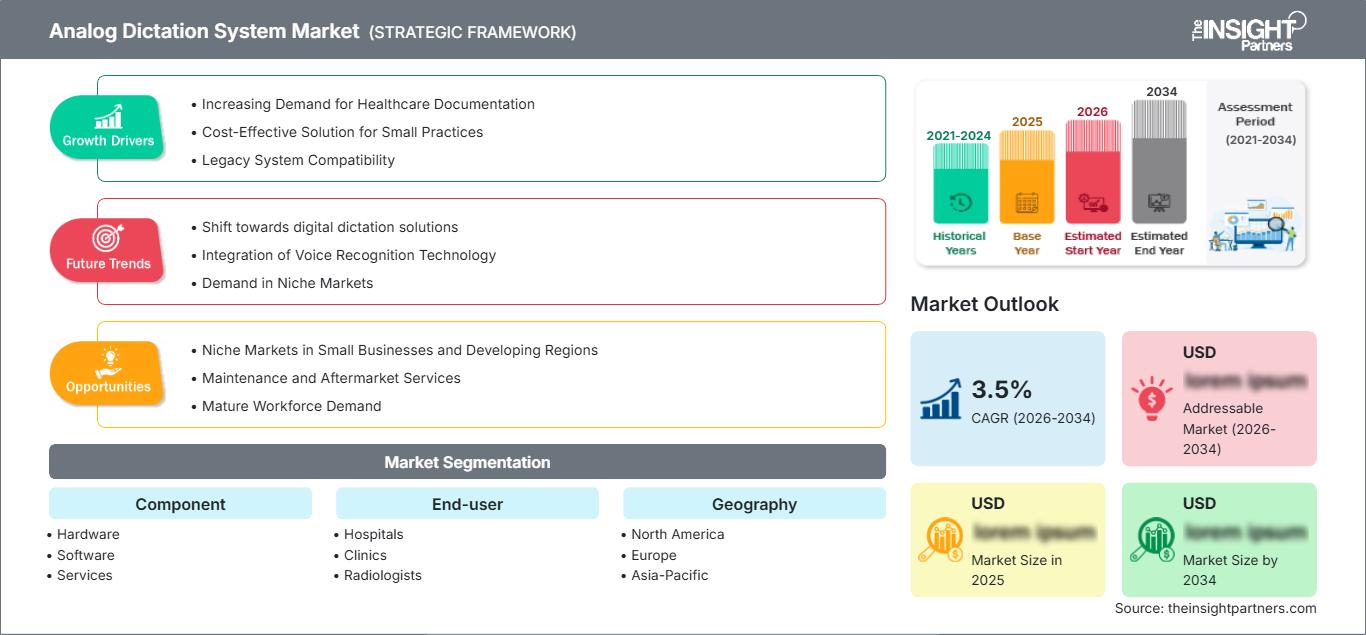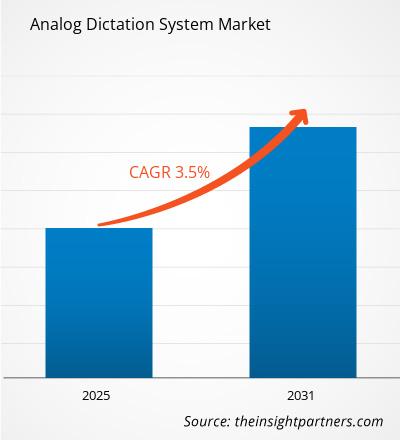Der Markt für analoge Diktiergeräte wird voraussichtlich von 2026 bis 2034 mit einer durchschnittlichen jährlichen Wachstumsrate (CAGR) von 3,5 % wachsen. Die Marktbedingungen entwickeln sich stetig weiter und eröffnen den Akteuren neue Chancen. Insgesamt zeichnet sich der Markt durch stabile Fortschritte und langfristiges Wachstumspotenzial ab.
Der Bericht ist nach Komponenten (Hardware, Software, Dienstleistungen) und Endnutzern (Krankenhäuser, Kliniken, Radiologen, Sonstige) gegliedert. Die globale Analyse wird zudem auf regionaler Ebene und für wichtige Länder aufgeschlüsselt. Der Bericht gibt die Werte der oben genannten Analysen und Segmente in US-Dollar an.
Zweck des Berichts
Der Bericht „Markt für analoge Diktiersysteme“ von The Insight Partners beschreibt die aktuelle Marktlage und das zukünftige Wachstum, die wichtigsten Triebkräfte, Herausforderungen und Chancen. Er bietet Einblicke für verschiedene Akteure im Markt, wie zum Beispiel:
- Technologieanbieter/Hersteller: Um die sich entwickelnde Marktdynamik zu verstehen und die potenziellen Wachstumschancen zu erkennen, damit sie fundierte strategische Entscheidungen treffen können.
- Investoren: Um eine umfassende Trendanalyse hinsichtlich der Marktwachstumsrate, der finanziellen Marktprognosen und der Chancen entlang der gesamten Wertschöpfungskette durchzuführen.
- Regulierungsbehörden: Zur Regulierung von Richtlinien und Überwachungstätigkeiten auf dem Markt mit dem Ziel, Missbrauch zu minimieren, das Vertrauen der Anleger zu erhalten und die Integrität und Stabilität des Marktes zu wahren.
Marktsegmentierungskomponente für analoge Diktiersysteme
- Hardware
- Software
- Dienstleistungen
Endbenutzer
- Krankenhäuser
- Kliniken
- Radiologen
- Andere
Sie erhalten eine kostenlose Anpassung aller Berichte – einschließlich Teilen dieses Berichts, Länderanalysen und Excel-Datenpaketen – sowie attraktive Angebote und Rabatte für Start-ups und Universitäten.
Markt für analoge Diktiersysteme: Strategische Einblicke

-
Ermitteln Sie die wichtigsten Markttrends dieses Berichts.Diese KOSTENLOSE Probe beinhaltet eine Datenanalyse, die von Markttrends bis hin zu Schätzungen und Prognosen reicht.
Wachstumstreiber des Marktes für analoge Diktiersysteme
- Steigende Nachfrage nach medizinischer Dokumentation: Der zunehmende Bedarf an präziser und effizienter medizinischer Dokumentation treibt den Markt für analoge Diktiergeräte an. Medizinische Fachkräfte nutzen Diktiergeräte, um Patienteninformationen, Rezepte und medizinische Berichte schnell zu erfassen und so Arbeitsabläufe und Patientenversorgung zu optimieren sowie den Verwaltungsaufwand für das medizinische Personal zu reduzieren.
- Kostengünstige Lösung für kleine Praxen: Analoge Diktiergeräte sind für kleine Arztpraxen und Kliniken sehr attraktiv, da sie günstiger und einfacher zu bedienen sind. Digitale Systeme hingegen erfordern oft komplexe Installationen und verursachen laufende Wartungskosten. Daher werden analoge Systeme in kleineren Gesundheitseinrichtungen weiterhin eingesetzt, da sie eine einfache und kostengünstige Möglichkeit zur effizienten Dokumentation bieten.
- Kompatibilität mit Altsystemen: Viele Gesundheitseinrichtungen arbeiten mit Altsystemen; Diktate sind nach wie vor eine wichtige Methode, mit der medizinisches Fachpersonal Informationen dokumentiert. Systeme können stets mit älterer Technologie ausgestattet sein, um einen für die jeweilige Einrichtung vertrauten Arbeitsablauf zu gewährleisten. Daher werden sie weiterhin genutzt, selbst wenn moderne digitale Versionen auf dem Markt verfügbar sind. Die Nutzung von Altsystemen erfüllt die notwendigen Anforderungen für die Verwendung analoger Systeme.
Markt für analoge Diktiersysteme – Zukunftstrends
- Umstellung auf digitale Diktierlösungen: Der Markt für analoge Diktiergeräte wandelt sich hin zu digitalen Systemen, da die digitale Technologie mehr Komfort, schnellere Verarbeitung und größere Speicherkapazitäten bietet. Zudem verbessert sie die Transkriptionsgenauigkeit und erhöht die Sicherheit. Da Unternehmen und Freiberufler zunehmend auf digitale Alternativen setzen, sinkt die Nachfrage nach analogen Diktiergeräten stetig, was den Bedarf an einer Markttransformation hin zu digitalen Lösungen weiter steigert.
- Integration der Spracherkennungstechnologie: Die Spracherkennungstechnologie wird zunehmend in Diktiergeräte integriert, selbst in analoge Systeme. Diese Technologien ermöglichen die Echtzeit-Transkription und reduzieren so die Abhängigkeit von manuellen Transkriptoren. Die höhere Genauigkeit und Funktionalität der Spracherkennung steigern die Effizienz der Diktierfunktion, wodurch sich der Markt erweitert und der Übergang von traditionellen analogen Systemen zu fortschrittlichen Lösungen gefördert wird.
- Nachfrage in Nischenmärkten: Analoge Diktiergeräte existieren möglicherweise noch in Nischenmärkten, wo sie trotz des Wachstums des Marktes für digitale Lösungen aufgrund branchenspezifischer Bedürfnisse weiterhin eingesetzt werden. In Branchen wie dem Rechts- oder Medizinwesen bevorzugen Anwender analoge Diktiergeräte aufgrund ihrer Einfachheit und Zuverlässigkeit, was die Nutzung angenehmer macht. Daher unterliegt der Markt keinen Schwankungen, da diese Berufsgruppen weiterhin auf analoge Diktiergeräte für bestimmte Zwecke angewiesen sind.
Marktchancen für analoge Diktiersysteme
- Nischenmärkte in kleinen Unternehmen und Entwicklungsländern: Analoge Diktiergeräte bieten weiterhin Chancen in Nischenmärkten, insbesondere in Entwicklungsländern oder kleinen Unternehmen, wo Erschwinglichkeit, Einfachheit und Low-Tech-Lösungen hoch geschätzt werden. Diese Geräte bieten eine unkomplizierte Lösung für die Patientendokumentation in Krankenhäusern und Kliniken und ermöglichen die effiziente Erfassung medizinischer Daten ohne komplexe Softwareanforderungen.
- Wartung und Kundendienst: Da die installierte Basis analoger Diktiergeräte zunehmend altert, ergeben sich Chancen für Unternehmen, die sich auf Wartung, Reparatur und Support für ältere Geräte spezialisieren. Diese Dienstleistungen sind entscheidend für Organisationen, die ihre bestehenden Systeme weiterhin nutzen möchten, ohne die Kosten einer vollständigen Modernisierung tragen zu müssen.
- Nachfrage älterer Arbeitnehmer: Die Babyboomer erreichen das Rentenalter, und viele in Berufen wie dem Gesundheitswesen, der Rechtsbranche oder der Wirtschaft bevorzugen aufgrund ihrer einfachen Bedienung weiterhin analoge Diktiergeräte. Da diese Berufsgruppe mit digitalen Lösungen weniger vertraut ist, bietet sich hier eine einzigartige Marktchance: Durch das Angebot benutzerfreundlicher analoger Geräte kann die Produktivität am Arbeitsplatz auch für ältere Arbeitnehmer gewährleistet und gleichzeitig deren Bedürfnisse berücksichtigt werden.
Markt für analoge Diktiersysteme – Regionale Einblicke
Die regionalen Trends und Einflussfaktoren auf den Markt für analoge Diktiergeräte im gesamten Prognosezeitraum wurden von den Analysten von The Insight Partners eingehend erläutert. Dieser Abschnitt behandelt außerdem die Marktsegmente und die geografische Verteilung des Marktes für analoge Diktiergeräte in Nordamerika, Europa, Asien-Pazifik, dem Nahen Osten und Afrika sowie Süd- und Mittelamerika.
Marktbericht über analoge Diktiersysteme – Umfang
| Berichtattribute | Details |
|---|---|
| Marktgröße im Jahr 2025 | XX Millionen US-Dollar |
| Marktgröße bis 2034 | XX Millionen US-Dollar |
| Globale durchschnittliche jährliche Wachstumsrate (2026 - 2034) | 3,5 % |
| Historische Daten | 2021-2024 |
| Prognosezeitraum | 2026–2034 |
| Abgedeckte Segmente |
Nach Komponente
|
| Abgedeckte Regionen und Länder |
Nordamerika
|
| Marktführer und wichtige Unternehmensprofile |
|
Marktdichte analoger Diktiersysteme: Auswirkungen auf die Geschäftsdynamik verstehen
Der Markt für analoge Diktiergeräte wächst rasant, angetrieben durch die steigende Nachfrage der Endnutzer. Gründe hierfür sind unter anderem sich wandelnde Verbraucherpräferenzen, technologische Fortschritte und ein wachsendes Bewusstsein für die Vorteile des Produkts. Mit steigender Nachfrage erweitern Unternehmen ihr Angebot, entwickeln innovative Lösungen, um den Kundenbedürfnissen gerecht zu werden, und nutzen neue Trends, was das Marktwachstum zusätzlich beflügelt.

- Verschaffen Sie sich einen Überblick über die wichtigsten Akteure auf dem Markt für analoge Diktiersysteme.
Wichtigste Verkaufsargumente
- Umfassende Abdeckung: Der Bericht bietet eine umfassende Analyse der Produkte, Dienstleistungen, Typen und Endnutzer des Marktes für analoge Diktiersysteme und vermittelt so ein ganzheitliches Bild.
- Expertenanalyse: Der Bericht basiert auf dem fundierten Wissen von Branchenexperten und Analysten.
- Aktuelle Informationen: Der Bericht gewährleistet Geschäftsrelevanz durch die Berücksichtigung aktueller Informationen und Datentrends.
- Anpassungsmöglichkeiten: Dieser Bericht kann an die spezifischen Anforderungen des Kunden angepasst werden und sich optimal in die Geschäftsstrategien einfügen.
Der Forschungsbericht zum Markt für analoge Diktiersysteme kann daher maßgeblich dazu beitragen, die Branchensituation und die Wachstumsaussichten zu entschlüsseln und zu verstehen. Auch wenn einige berechtigte Bedenken bestehen, überwiegen die Vorteile dieses Berichts insgesamt die Nachteile.
- Historische Analyse (2 Jahre), Basisjahr, Prognose (7 Jahre) mit CAGR
- PEST- und SWOT-Analyse
- Marktgröße Wert/Volumen – Global, Regional, Land
- Branchen- und Wettbewerbslandschaft
- Excel-Datensatz
Aktuelle Berichte
Erfahrungsberichte
Grund zum Kauf
- Fundierte Entscheidungsfindung
- Marktdynamik verstehen
- Wettbewerbsanalyse
- Kundeneinblicke
- Marktprognosen
- Risikominimierung
- Strategische Planung
- Investitionsbegründung
- Identifizierung neuer Märkte
- Verbesserung von Marketingstrategien
- Steigerung der Betriebseffizienz
- Anpassung an regulatorische Trends






















 Kostenlose Probe anfordern für - Markt für analoge Diktiersysteme
Kostenlose Probe anfordern für - Markt für analoge Diktiersysteme